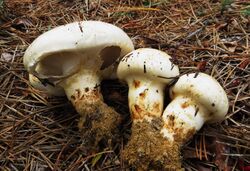Biology:Tricholoma magnivelare
| Tricholoma magnivelare | |
|---|---|

| |
| Scientific classification | |
| Domain: | Eukaryota |
| Kingdom: | Fungi |
| Division: | Basidiomycota |
| Class: | Agaricomycetes |
| Order: | Agaricales |
| Family: | Tricholomataceae |
| Genus: | Tricholoma |
| Species: | T. magnivelare
|
| Binomial name | |
| Tricholoma magnivelare (Peck) Redhead (1984)
| |
| Synonyms[1] | |
| |
Tricholoma magnivelare, commonly known as the matsutake, white matsutake,[2] ponderosa mushroom, pine mushroom, or American matsutake,[3] is a gilled mushroom found East of the Rocky Mountains in North America growing in coniferous woodland. These ectomycorrhizal fungi are typically edible species that exist in a symbiotic relationship with various species of pine, commonly jack pine. They belong to the genus Tricholoma, which includes the closely related East Asian songi or matsutake as well as the Western matsutake (T. murrillianum) and Meso-American matsutake (Tricholoma mesoamericanum).
Species designation
Until recently, Tricholoma magnivelare was the name used to describe all matsutake mushrooms found growing in North America. Since the early 2000s, molecular data has indicated the presence of separate species previously grouped within T. magnivelare. Only those found in the Eastern United States and Canada have retained the T. magnivelare name.[4]
Description
The cap ranges from 5–20 cm (2–7 7⁄8 in) in width, and is white with reddish-yellow or brown spots. The stalk is 4–15 cm (1 5⁄8–5 7⁄8 in) tall and 2–6 cm wide. The spores are white.[5]
The mycelium is thought to be parasitized by the plant Allotropa virgata,[6] which primarily feeds on matsutake.[7]
Chemistry
This mushroom is noted for its distinctive odour/flavour. The major compound identified from fresh sporocarps is the fragrant compound, methyl cinnamate. Also, alpha-pinene and bornyl acetate are present in trace amounts in uncrushed samples. Tissue disruption of the sporocarp produces large amounts of 1-octen-3-ol, a compound found in many mushrooms that has a typical mushroom-like odour. Cultures of the secondary mycelium of T. magnivelare did not have any of the compounds found in the sporocarp. The major volatile component of mycelial cultures is 3,5-dichloro-4-methoxybenzaldehyde. 3,5-Dichloro-4-methoxybenzyl alcohol and hexanal were identified as minor components from these cultures. [8]
Edibility
While tough,[5] the mushroom can be eaten both raw and cooked[9] and is considered choice.[10] In recent years, globalization and wider social acceptability of mushroom hunting has made collection of pine mushrooms widely popular in North America.
Local mushroom hunters sell their harvest daily to local depots, which rush them to airports. The mushrooms are then shipped fresh by air to Asia where demand is high and prices are at a premium.[11]
Serious poisonings have resulted from confusion of this mushroom with poisonous white Amanita species.[12]
Similar species
Similar species in the genus include Tricholoma apium,[6] T. caligatum, T. focale, and T. vernaticum.[5] Other similar species include Catathelasma imperiale, C. ventricosum, Russula brevipes, and the poisonous Amanita smithiana.[6]
See also
- List of North American Tricholoma
- List of Tricholoma species
References
| Tricholoma magnivelare | |
|---|---|
| Mycological characteristics | |
| gills on hymenium | |
| cap is convex | |
| hymenium is adnate or adnexed | |
| stipe has a ring | |
| spore print is white | |
| ecology is mycorrhizal | |
| edibility: choice | |
- ↑ "GSD Species Synonymy: Tricholoma magnivelare (Peck) Redhead". Species Fungorum. CAB International. http://www.speciesfungorum.org/GSD/GSDspecies.asp?RecordID=106520.
- ↑ Arora, David (1986). Mushrooms demystified: a comprehensive guide to the fleshy fungi (Second ed.). Berkeley: Ten Speed Press. ISBN 978-0-89815-169-5.
- ↑ Tricholoma magnivelare. Botany.Wisc.edu. Accessed March 23, 2012.
- ↑ Trudell, Steven A.; Xu, Jianping; Saar, Irja; Justo, Alfredo; Cifuentes, Joaquin (May 2017). "North American matsutake: names clarified and a new species described". Mycologia 109 (3): 379–390. doi:10.1080/00275514.2017.1326780. ISSN 0027-5514. PMID 28609221.
- ↑ 5.0 5.1 5.2 Davis, R. Michael; Sommer, Robert; Menge, John A. (2012). Field Guide to Mushrooms of Western North America. Berkeley: University of California Press. pp. 163–164. ISBN 978-0-520-95360-4. OCLC 797915861. https://www.worldcat.org/oclc/797915861.
- ↑ 6.0 6.1 6.2 Trudell, Steve; Ammirati, Joe (2009). Mushrooms of the Pacific Northwest. Timber Press Field Guides. Portland, OR: Timber Press. pp. 104–105. ISBN 978-0-88192-935-5. https://books.google.com/books?id=WevHvt6Tr8kC.
- ↑ Moore, Andy. "Allotropa Virgata". https://matsiman.com/allotropa.htm.
- ↑ Wood W. F.; Lefevre C. K. (2007). "Changing volatile compounds from mycelium and sporocarp of American matsutake mushroom, ‘’Tricholoma magnivelare’’". Biochemical Systematics and Ecology 35: 634-636. doi:10.1016/j.bse.2007.03.001.
- ↑ Meuninck, Jim (2017). Foraging Mushrooms Oregon: Finding, Identifying, and Preparing Edible Wild Mushrooms. Falcon Guides. p. 101. ISBN 978-1-4930-2669-2.
- ↑ Phillips, Roger (2010). Mushrooms and Other Fungi of North America. Buffalo, NY: Firefly Books. p. 42. ISBN 978-1-55407-651-2. https://archive.org/details/mushroomsotherfu0000phil.
- ↑ The American Matsutake: Tricholoma magnivelare. Mushroom Expert. Accessed March 23, 2012.
- ↑ Tulloss RE.. "Amanita smithiana". Amanitaceae.org. http://www.amanitaceae.org/?Amanita%20smithiana.
External links
Wikidata ☰ Q7840804 entry
 |

